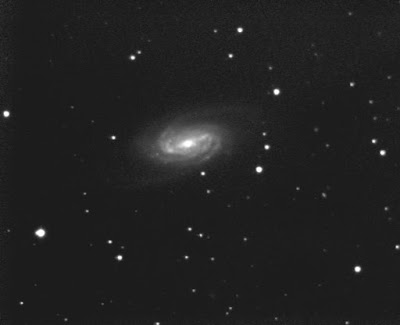
Here is a completed map of the NGC 2903 image.
Folks from the NHAC have helped me answer some of the questions I posted about it. In particular, Kenneth (drako) Drake confirmed that the potential galaxy is actually a galaxy. I had looked at the POSS prints, and some deeper amateur photos, and it looked like a galaxy to me, but drako reported that Larry Mitchell, a long-time deep-sky observer---a real expert, had catalogued it as a galaxy. Here are the stats: Mitchell Anonymous Catalog [MAC] 0932+2121. Mag: 16.5. Size: 0.5'x0.1.' RA: 09h 32m 18.7s. Dec: +21° 21' 25."
Drako also inadvertently helped solve another puzzle in the image. An object appeared to be moving during the exposures. On the combined image, it appears as a short streak rather than a point. A few weeks ago, drako gave the NHAC listserv a notice of near-earth asteroid TU24 and pointed out the JPL website that calculates ephemerides for asteroids. I had earlier found a Lowell Observatory website (here) that would identify asteroids in the vicinity if I entered a time and coordinates. After finding an asteroid in the vicinity on the Lowell site, I obtained an ephemeris from the JPL site, then plotted the path of the asteroid in a detailed online atlas. Sure enough, asteroid #1210 Morovisia, mag. 14.7, was right in the image while it was being taken. It was right where the streaky line is, going in the direction of the streak, and the magnitude is within range.
Amazing! I still can't believe I can do this from the backyard, and I can't believe what one can catch with such a simple camera and simple procedure.
Thanks NHAC and Kenneth Drake, for sharing.


